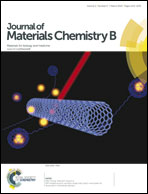The template role of caffeine in its one-step encapsulation in MOF NH2-MIL-88B(Fe)†
Abstract
A simple and efficient one-step encapsulation of caffeine was carried out in MOF NH2-MIL-88B(Fe) and compared to the traditional three-stage synthesis–activation–encapsulation procedure. Caffeine was added to the synthesis solution of a MOF whose structure was formed around the caffeine itself. The caffeine loading was 35 wt%. The presence of this molecule in the synthesis solution led to swollen CAF@NH2-MIL-88B(Fe) when a different framework (NH2-MIL-53(Fe)) was obtained without caffeine. For comparison, the ex situ encapsulation of caffeine was also carried out in NH2-MIL-88B(Fe), once this material was obtained upon activation of NH2-MIL-53(Fe). The release of caffeine and aminoterephthalic acid (the ligand used to obtain MOFs) from different materials was studied both in water and phosphate buffered saline (PBS). Caffeine plays the role of a structure directing agent or template since its presence led to obtaining a different MOF. In addition, caffeine contributed to the liquid phase stability of the MOF, as demonstrated through the release of the ligand from both CAF@NH2-MIL-88B(Fe) (slower release) and NH2-MIL-88B(Fe) (faster release). Chemical and structural evidence indicated hydrogen bond interactions between caffeine and MOF.


 Please wait while we load your content...
Please wait while we load your content...